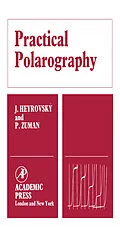Practical Polarography: An Introduction for Chemistry Students provides information pertinent to the fundamental aspects of practical polarography. This book presents the developments in polarography and provides descriptions and procedures that should be readily available for use with any available polarograph.
Organized into eight chapters, this book begins with an overview of polarography that is widely employed in chemical analysis because the current-voltage curves show both the quantitative and qualitative composition of the solution. This text then explains the electrode in polarographic electrolysis, which consists either of a mercury pool at the bottom of the electrolytic cell that contains the solution under test, or of a special type of electrode of known potential. Other chapters consider the polarographic reduction of some metal ions and of some organic substances. The final chapter deals with the tables containing selected data of half-wave potentials measured against a saturated calomel electrode at 20-25°C.
This book is a valuable resource for students, technicians, and chemists.
Inhalt
Preface
I. Introduction
1. Principles of Polarography
2. The Dropping Electrode
3. Fundamental Measurements Using a Simple Arrangement; Polarographic Curve
4. Reference Electrodes
5. Polarographic Cells
6. Supporting (Base) Electrolyte
7. Removal of Oxygen
8. Protection from Mercury Poisoning
II. Polarographic Curves and their Interpretation
1. Type of Electrode Processes at the Dropping Electrode
2. Types of Polarographic Limiting Currents
3. Measurement of Limiting Currents
4. Significance and Measurement of Half-Wave Potentials
III. Application of Instruments
1. Polarographs and Some Auxiliary Electrical Equipment
2. Handling of Photographic Recording Polarographs
3. Handling of Pen Recording Polarographs
4. Checking the Apparatus
5. Disturbances and their Elimination
IV. Simple Polarographic Determinations
1. Determination of Hydrogen Peroxide
2. Barium Traces in Strontium(II) Salts; the Method of Standard Addition
3. Reduction of Iodate and Bromate
4. Traces of Bromate in Chlorate
5. Determination of Iodate in Chile Saltpetre
6. Polarographic Spectrum
7. Determination of Zinc Dioxide in Lithopone
8. Determination of Copper and Zinc in Brass
9. Acetaldehyde and Formaldehyde
10. Determination of Formaldehyde in Pharmaceuticals
11. Purity of Ether
12. Reduction Waves of Glucose and Fructose
13. Determination of Fructose in Honey
14. Anodic Oxidation of Ascorbic Acid
15. Determination of Traces of Nitrobenzene in Aniline
16. Determination of Cystine
17. Protein Reaction (according to Brdicka)
V. More Advanced Procedures in the Absence of Air
1. Determination of Nitrate and Nitrite
2. Anodic Waves of Chloride Ions
3. Reduction and Oxidation Waves of Iron
4. Oxygen Determination
5. Acetone Determination
6. Determination of Alkali Metals; Application of Derivative Curves
7. Separation of Overlapping Waves
8. Consecutive Reductions
VI. Examples of Practical Applications
1. Metallurgical
2. Polarographic Behaviour of Organic Substances
3. Applications in Pharmacy and Biochemistry
4. Polarography in the Food Industry
5. Polarography in Medicine
6. Microanalytical Determinations
7. Suppression of Maxima
8. Polarometric (Amperometric) Titrations
VII. Most Important Buffers
VIII. Tables of Half-Wave Potentials
Bibliography
Subject Index
